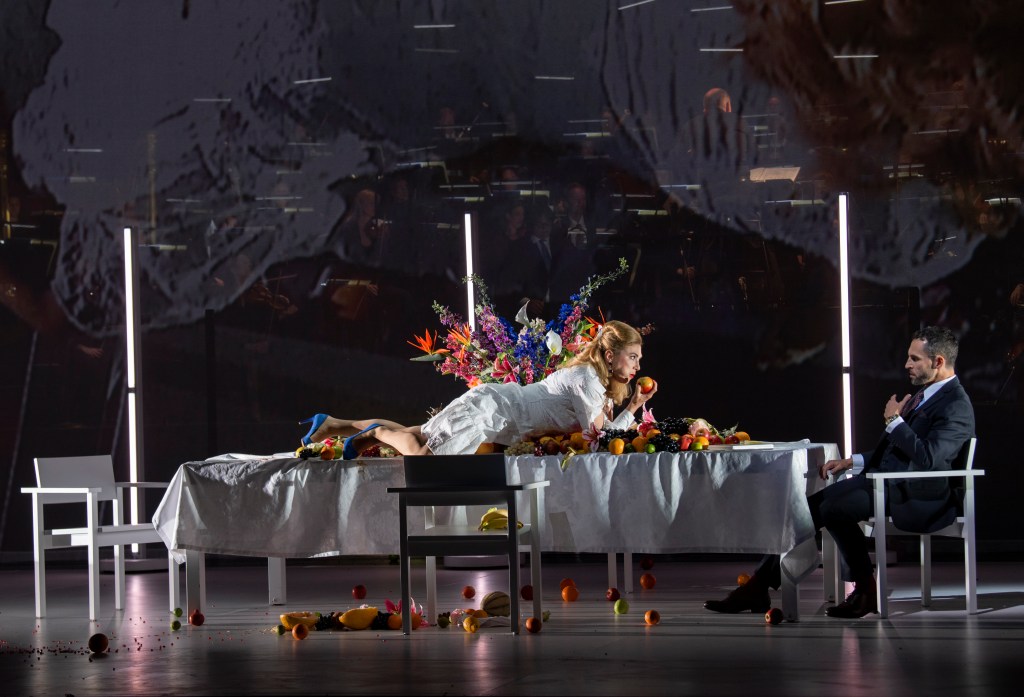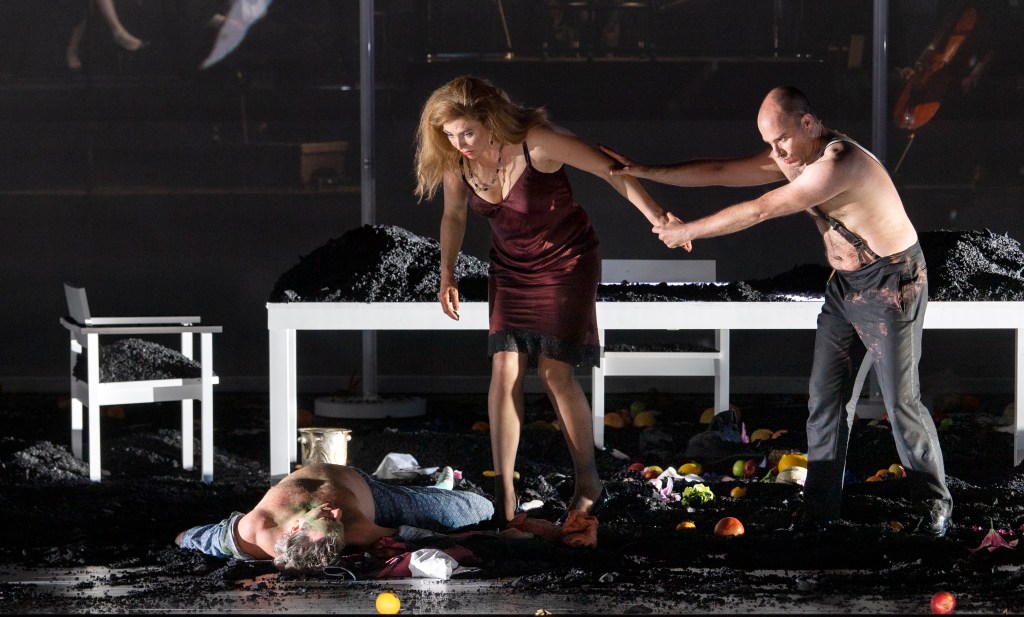Text: Neil van der Linden
Rudi Stephan’s opera or ‘Erotic Mystery’ Die ersten Menschen was to be premiered early 1915, but WWI intervened. In September that same year the composer died at Germany’s Eastern front, by a bullet through his head

Rudi Stephan
In a way it was a surprise that the opera was to be performed at all. The libretto was based on an “Erotic Mystery” play that had been performed only once in 1912 in München, before it was banned for its explicit content. It was a hyper-eroticised and quite anti-religious view on the first family on earth, Adahm and Chawa, and their sons, Kajin and Chabel (resp. Adam, Eve, Cain and Abel), by Otto Börngraber, now mostly forgotten, but then a well-known radical playwright and philosopher.
In it, Adahm and Chawa are growing older, after having been expelled from paradise. Adahm has become contemplative, focusing on acquiring knowledge through science. Chawa longs back for the days of their youth. Meanwhile Kajin, the older son, is expressing a desire to explore the world, and to look for a ‘wild woman’, but he never gets far. Chabel, the youngest, is into mysticism and prophesies about a redeemer who will come, to be sacrificed as a lamb. In fact, Chabel brings a lamb along, and cuts its throat. Adahm goes out, Kajin tries to seduce Chawa, Chawa tries to seduce Chabel, Kajin kills Chabel and drops on a funeral pyre, Chawa wants to follow Chabel, but Adahm returns and draws her away, Adah and Chawa walk into the sunrise of a new day and Kajin will be the father of humankind.
This mystic and simultaneously sensual and blasphemous family drama is clickbait for director Calixto Bieto, of whom you could somewhat profanely say that he turns everything into mystic and simultaneously sensual and blasphemous family drama. Although first the plan -shelved due to COVID19 – was to have him stage Berlioz’s Damnation de Faust, on which Bieito for sure would have been able to apply his signature key-elements in staging as well: trivialising the sacred and sanctifying the trivial.
On stage we see a geometrical tent-like structure covered with gauze, the see-through home of this vulnerable first family on earth. There is a table covered with plates, filled with piles of fruit. They of course remind us of Eve and Adam having eaten the forbidden fruit from the Biblical Tree of Knowledge of Good and Evil. During the whole performance Chawa will be eating more fruits, trampling on them, or serving their contents to the other characters. The backdrop is a gauze with video-images of more fruits, alternating with lips, eyes and body parts, and later on the protagonists in close-up. Incidentally we get to see the orchestra behind it, onstage, with conductor François-Xavier Roth, sometimes just the lights of the orchestra’s music-stands, shining through like the stars Chabel sees in his visions.

Director Calixto Bieito;Set design Rebecca Ringst; Costumes Ingo Krügler; Lighting Michael Bauer; Video Sarah Derendinger; Adahm Kyle Ketelsen Kaijn Leigh Melrose; Chawa Annette Dasch; Chabel John Osborne;
In the opening scenes Adahm is sitting behind a white laptop, focusing on the screen instead of Chawa. Later on Adahm recounts a white, shiny miracle that he saw during the moment when the Knowledge of Good and Evil was revealed to him, so yes in a way the laptop is in the text. And yes, this is the Bieito method, reducing mythological allusions to seemingly trivial objects, that meanwhile retell the story in their own way.
It reminded me of Ruth Berghaus’ staging of Berg’s Lulu in Brussels; I remember countess Geschwitz, last one in love with Lulu, unreciprocated, vacuuming the run-down attic where she and Lulu, after living a luxurious life, are prostituting themselves –the whole staging was worlds apart from the previous staging in Paris, with the same magnificent Teresa Stratas in the title role, where Patrice Chéreau had given the characters a luscious beau-monde surrounding till the end.
The lamb that Chabel introduces in the family circle here is presented in the shape of a stuffed animal toy that he keeps caressing, behaving like a big baby. Yet, without any hesitation he decapitates his pet toy when the moment of the sacrifice arrives. The toy turns out to be filled with blood, which gushes out.
The role was performed by John Osborn, thus the role was cast as lyrical rather than as Wagnerian. Osborn often almost pushes his voice into falsetto, bringing the character closer to for instance the fool in Boris Godounov than a Wagnerian ‘Held’, and John Osborn really is the perfect performer for this, and Bieito makes full use of him. After having ‘killed’ the toy lamb, all the while showing the smile of a lunatic, he returns in pyjamas, which reveal the singer’s somewhat voluminous belly, making him so the more appear like an oversized toddler.

Kajin clings to Chawa after he murdered Chabel
Meanwhile, his brother Kajin (superbly performed by baritone Leigh Melrose) gets to show his somewhat voluminous belly as well, but in his turn a more mannish one, as befits his character, covered abundantly with chest hair. All this leads to a scene where mother Chawa (a commanding Annette Dasch with some very demanding notes over full orchestra) strips as well, down to a negligée. And yes, still quite in line with the libretto, consecutively Kajin tries to rape Chawa, Chawa tries to rape Chabel, all join in a threesome, Kajin tries to rape Chabel, and Kajin kills Chabel.

Kajin rapes Chawa
Enter Adahm (bass-baritone Kyle Ketelsen). Apparently untouched by all the hormones flying around, Adahm stays dressed, in the end even wearing a plain raincoat on top of everything. There is no sunrise outside to walk into, but Adahm and Chawa embrace, in closeup in the backdrop video, in loving caressing.
Stephan’s musical idiom oscillates between the budding atonality of Schönberg’s Erwartung (finished 1909) and the stretched tonal idiom of Schreker; Schreker’s Die Gezeichneten was written during the same years as Die Erste Menschen. The topic is not that distant from the incest of Strauss’ Salomé, the sexual craving in Erwartung, the promiscuity of Die Gezeichneten, all topics that were already present in Wagner’s Ring meanwhile.
It took Stephan a while to finish the opera, partly it seems as librettist Börngraber had been thinking Richard Strauss might instead be interested in the text. But Strauss had already abandoned his taste for topics like Salomé and Elektra, replacing it with the saccharine world of Der Rosenkavalier, which premiered in 1911.
Finally, Die Erste Menschen was staged in 1920 in Frankfurt, to critical acclaim, but without winning the hearts of audiences. After a second failure in 1924 in an abridged, chastened version, it disappeared. This Amsterdam production is only the second post WWII production of the full score. And without Corona we would not even have had this ravishing gem. Berlioz’ Damnation will wait.
Adahm: Kyle Ketelsen
Kajin: Leigh Melrose
Chawa: Annette Dasch
Chabel: John Osborn
Musical direction: François-Xavier Roth
Direction: Calixto Bieito
Set design: Rebecca Ringst
Costumes Ingo Krügler
Lighting: Michael Bauer
Video: Sarah Derendinger
Orchestra: Royal Concertgebouw Orchestra
This production is part of the Holland Festival 2021
Photography Ruth Walz
The production can be seen on ARTE and on the websites of the Holland Festival and the Dutch National Opera & Ballet from June 25th on, for free:
https://www.arte.tv/en/videos/084458-006-A/the-first-humans-trailer/



Een Duitse opera en een Engelse recensie over een werk dat in Nederland z’n première beleeft. Nou ja vooruit dan maar weer. Het was absoluut een overweldigende ervaring qua zang en qua productie.
Calixto Bieito had er echt iets spannends van gemaakt zonder in de hem zo eigenzinnige ranzigheden te vervallen. Vier topsolisten die de moeite hadden genomen om dit moeilijke werk in te studeren bezorgden mij een fantastische opera-avond, na 15 maanden stilte.
LikeGeliked door 1 persoon
Zo kunnen de zangers het ook lezen 🙂
LikeLike
Onzin, de kranten schrijven ook Gewoon in onze eigen taal
LikeLike
Gisterenavond (9-06-2021) heb ik deze fascinerende voorstelling bijgewoond. Wat direct opviel was het grote contrast tussen de verheven tekst en wat er op het toneel plaatsvond. Het was dan weliswaar het Bijbelse verhaal van Adam en Eva en Caïn en Abel maar tegelijkertijd was het een uit de hand gelopen familiediner in de betere kringen. Het witte tafellaken van de burgerlijke cultuur werd besmeurd met de oersappen van het driftleven. De formidabele zangers waren ook meesterlijke acteurs. Wat van hen verlangd werd grenste aan het onmogelijke. Hoe Annette Dasch met haar stiletto hak een sinaasappel spieste was ongelooflijk. De sensuele muziek deed sterk aan Wagner en Debussy denken en wist van het begin tot het einde te boeien. Chawa deed me aan Kundry denken. Adahm aan Wotan. Chabel aan Lohengrin en Parsifal en Kajin aan Alberich. Het KCO speelde geweldig onder François-Xavier Roth. Vooral Femke IJlstra de briljante altsaxofonist dient vermeld te worden.Ik zat in de zaal op de derde rij vooraan. Een zeer gevaarlijke plaats want de sinaasappelen en meloenen vlogen me om de oren. Freud en fruit doen het altijd goed.
De recensie van Neil van der Linden hierboven is
een uitstekend weergave van de voorstelling. Kan de storende spellingsfouten in de kop verbeterd worden?
LikeGeliked door 1 persoon
bedankt Rudolph. Fout verbeterd
LikeLike
Wel ironisch dat ik spellingsfouten schrijf waar spellingsfout moet staan.
LikeGeliked door 1 persoon
het zijn typo’s Rudolph. En het gekke is: je ziet ze niet al lees en herlees je het.
Vandaar dat het fijn is dat iemand het opmerkt
LikeLike